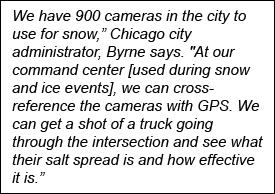
City and county budgets have been slashed over the past few years, but residents still expect the same level of service they enjoyed during more prosperous times. Public works departments still must pick up garbage and recyclables, repair potholes, and maintain other services, but with less money. In some cities, public works departments are finding ways to go beyond the status quo, creatively using technology to improve services in an affordable way.
For instance, a new city administration in Chicago recently initiated a 10 percent budget cut across all departments, but services continue to improve, thanks to creative solutions implemented by Thomas Byrne, commissioner of the Department of Streets and Sanitation. One ward supervisor oversees each of the city’s 50 wards, and those supervisors once spent many hours driving around their wards, keeping up with the sanitation trucks assigned to them and making sure they stayed on schedule. Byrne and his staff recently installed GPS devices in each sanitation truck, and connected those devices to Blackberry devices provided to the ward supervisors. “Now a ward supervisor can go to the [Chicago Mobile Asset Tracker] CMAT database with his Blackberry anytime and it shows him where each truck is that is assigned to him,” Byrne says. “They know exactly where all their trucks are all the time.”
Mobile Asset Tracking Keeps Tabs on Service Efficiencies
 A simple, relatively inexpensive fix, the GPS system was installed and programmed by internal staff and is saving time and money for city employees. “We were moving a lot of equipment around, and we just got some young, energetic tech guys in here to help us get it going,” Byrne says. “We started the mobile asset tracking in November 2010, and it’s been working well. We bring in the ward superintendents weekly and talk to them about their wards, and with the tracking program, they are very aware of what’s going on.”
A simple, relatively inexpensive fix, the GPS system was installed and programmed by internal staff and is saving time and money for city employees. “We were moving a lot of equipment around, and we just got some young, energetic tech guys in here to help us get it going,” Byrne says. “We started the mobile asset tracking in November 2010, and it’s been working well. We bring in the ward superintendents weekly and talk to them about their wards, and with the tracking program, they are very aware of what’s going on.”
In addition to tracking sanitation trucks, Chicago also uses GPS devices to keep up with snow trucks. “We have 900 cameras in the city to use for snow,” Byrne says. "At our command center [used during snow and ice events], we can cross-reference the cameras with GPS. We can get a shot of a truck going through the intersection and see what their salt spread is and how effective it is.”
Finally, Chicago’s public works department uses Blackberry handhelds to improve efficiency when writing tickets for untended vacant lots. “In the summertime, when people let the grass grow tall on a vacant lot, there’s a $500 fine,” Byrne explains. “But the hardest part of writing a ticket for a vacant lot is determining ownership. It’s easy to write the wrong address.”
With GPS-enabled Blackberrys, officials can stand on the lot in question and quickly determine its latitude and longitude, then communicate quickly with the central office to file a ticket, which will be sent directly to the property’s owner. “This system cuts time tremendously,” Byrne says.
Mobile Apps Empower Citizens and Improves Internal Operations
Chicago isn’t the only city using mobile technology to affordably make improvements to city services. In Arvada, Colo., for instance, public works officials are relying on help from local residents to keep them apprised of district problems. These cities offer free applications for residents’ smartphones that allow residents to instantly notify city officials about concerns or problems such as potholes, broken traffic lights, damaged playground equipment, graffiti, flooding, and fallen trees.
Such applications are making a difference in government efficiency, according to Chris Longshore, information systems manager in Arvada. “They are shortening the time to resolve issues, including pothole repair, graffiti clean-up, code violations and any other issues that are part of our day-to-day efforts,” he says. “Citizens feel like they are being heard. Using the mobile applications, a citizen who sees an issue can take a picture with their mobile device and have it sent right into the citizen relationship management application, where it is assigned through the system to the individual or group responsible for the issue, all with no manual intervention. This speeds our response and allows us to be more productive.”
In addition to mobile apps that are available for citizen use, Arvada also uses mobile technology for internal operations. The city’s building inspectors and utility services staffers are already using mobile technology in the field, and the city is experimenting with tablet and netbook technology to provide field access to mapping applications used by water, wastewater, streets and other divisions, Longshore says.
This article was guest-written by Nancy Mann Jackson
This blog entry was submitted by Nancy Mann Jackson. Nancy Mann Jackson is a freelance journalist who writes regularly about local government and sustainability issues. Learn more about her atwww.nancyjackson.com.
Related Articles
- More than Just Maps – How Public Works Departments are Realizing the true Power of GIS
- Case Study: Need to Improve your City Infrastructure on a Budget with Limited Resources and Still Save $30,000?
- Law Enforcement Gets the Decision Advantage with Affordable Next Generation GIS Apps
- Predictive Policing and the Role of GIS
















































